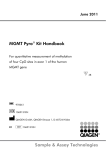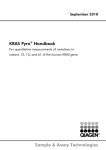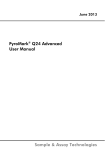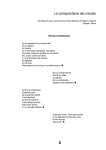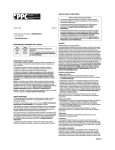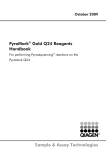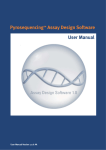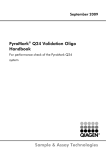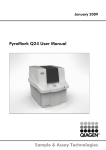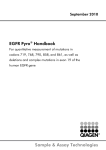Download Sample & Assay Technologies UGT1A1 Pyro® Handbook
Transcript
January 2011 UGT1A1 Pyro® Handbook For genotyping of the allele variants *28 and *6 of the human UGT1A1 gene Sample & Assay Technologies QIAGEN Sample and Assay Technologies QIAGEN is the leading provider of innovative sample and assay technologies, enabling the isolation and detection of contents of any biological sample. Our advanced, high-quality products and services ensure success from sample to result. QIAGEN sets standards in: Purification of DNA, RNA, and proteins Nucleic acid and protein assays microRNA research and RNAi Automation of sample and assay technologies Our mission is to enable you to achieve outstanding success and breakthroughs. For more information, visit www.qiagen.com. Contents Kit Contents 4 Shipping and Storage 5 Product Use Limitations 5 Safety Information 5 Quality Control 6 Introduction 7 Principle and procedure Equipment and Reagents to Be Supplied by User Important Notes 7 9 10 General precautions 10 Sample material 10 DNA isolation 10 Recommended plate mixers 11 Controls 11 Protocols 1: Run Setup for the PyroMark Q24 System 12 2: PCR Using the Reagents Supplied with the UGT1A1 Pyro Kit 14 3: Immobilization of PCR Products to Streptavidin Sepharose High Performance Beads 17 4: Preparation of Samples Prior to Pyrosequencing Analysis on the PyroMark Q24 System 19 5: Running the PyroMark Q24 System 23 6: Analysis of a PyroMark Q24 Run 26 Troubleshooting Guide 29 Appendix A: Setting Up UGT1A1 Pyro Assays 31 Appendix B: Emptying the Waste Container and Troughs 32 Ordering Information 33 UGT1A1 Pyro Handbook 01/2011 3 Kit Contents UGT1A1 Pyro Kit (box 1/2) UGT1A1 Pyro Kit Catalog no. Number of reactions (24) 970540 24 PCR Primer mix UGT1A1 *28 24 μl PCR Primer mix UGT1A1 *6 24 μl Seq Primer UGT1A1 *28 24 μl Seq Primer UGT1A1 *6 24 μl PyroMark® PCR Master Mix, 2x 850 μl CoralLoad® Concentrate, 10x 1.2 ml H2O Human Control DNA, 10 ng/μl 3 x 1.9 ml 100 μl Pyro Buffers and Reagents (box 2/2) Buffers and Reagents PyroMark Binding Buffer 10 ml PyroMark Annealing Buffer 10 ml PyroMark Denaturation Solution* 250 ml PyroMark Wash Buffer, 10x 25 ml Enzyme Mixture 1 vial Substrate Mixture 1 vial dATPS 1180 μl dCTP 1180 μl dGTP 1180 μl dTTP 1180 μl Handbook 1 * Contains sodium hydroxide. 4 UGT1A1 Pyro Handbook 01/2011 Shipping and Storage The UGT1A1 Pyro Kit is shipped in two boxes. The UGT1A1 Pyro Kit (box 1/2) is shipped on dry ice. PyroMark PCR Master Mix, CoralLoad Concentrate, control DNA, and all primers should be stored at –15 to –25°C upon arrival. The Pyro Buffers and Reagents (box 2/2) containing buffers, Enzyme Mixture, Substrate Mixture, dATPS, dCTP, dGTP, and dTTP (the reagents for Pyrosequencing® analysis) is shipped on cool packs. These components should be stored at 2–8°C upon arrival. To minimize loss of activity, it is advisable to keep both the enzyme mixture and the substrate mixture in the vials supplied. Reconstituted enzyme and substrate mixtures are stable for at least 5 days at 2–8°C. Reconstituted enzyme and substrate mixtures can be frozen and stored in their vials at –15 to –25°C. Frozen reagents should not be subjected to more than 3 freeze–thaw cycles. Important: Nucleotides should not be frozen. The UGT1A1 Pyro Kit is stable until the kit expiration date when stored under these conditions. Product Use Limitations The UGT1A1 Pyro Kit is intended for molecular biology applications. This product is not intended for the diagnosis, prevention, or treatment of a disease. We recommend all users of QIAGEN® products to adhere to the NIH guidelines that have been developed for recombinant DNA experiments, or to other applicable guidelines. Safety Information When working with chemicals, always wear a suitable lab coat, disposable gloves, and protective goggles. For more information, please consult the appropriate material safety data sheets (MSDSs). These are available online in convenient and compact PDF format at www.qiagen.com/Support/MSDS.aspx where you can find, view, and print the MSDS for each QIAGEN kit and kit component. UGT1A1 Pyro Handbook 01/2011 5 The following risk and safety phrases apply to components of the UGT1A1 Pyro Kit. PyroMark Denaturation Solution Contains sodium hydroxide: Irritant. Risk and safety phrases:* R36/38, S26-36/37/39-45 24-hour emergency information Emergency medical information in English, French, and German can be obtained 24 hours a day from: Poison Information Center Mainz, Germany Tel: +49-6131-19240 Quality Control In accordance with QIAGEN’s ISO-certified Quality Management System, each lot of the UGT1A1 Pyro Kit is tested against predetermined specifications to ensure consistent product quality. * R36/38: Irritating to eyes and skin; S26: In case of contact with eyes, rinse immediately with plenty of water and seek medical advice; S36: Wear suitable protective clothing; S37: Wear suitable gloves; S39: Wear eye/face protection; S45: In case of accident or if you feel unwell, seek medical advice immediately (show the label where possible). 6 UGT1A1 Pyro Handbook 01/2011 Introduction The UGT1A1 Pyro Kit is used for genotyping of the allele variant *28 (for distinguishing between 6 and 7 TA repeats) and allele variant *6 (for distinguishing between G and A genotype) of the human UGT1A1 gene. The kit consists of two assays: one for genotyping of allele variant *28 and the second for genotyping of allele variant *6 (Figure 1). The two regions are amplified separately by PCR and sequenced through the defined region. Sequences surrounding the defined positions serve as normalization and reference peaks for genotyping and quality assessment of the analysis. The product consists of a PCR primer mix and a sequencing primer for each assay. The primers are delivered in solution. Each vial contains 24 μl of each primer or primer mix. Note: The allele variant *28 is sequenced in reverse orientation and the allele variant *6 in forward orientation. FPB UGT1A1*28 CGG[TA]TATATA FP Seq Seq RP CA/GGAGCA UGT1A1*6 RPB Figure 1. Illustration of the UGT1A1 assays. The sequence indicated is the analyzed sequence with polymorphic nucleotides indicated by square brackets or slash. Part of the TA repeats analyzed with the UGT1A1 *28 assay are covered by the sequencing primer. FP, FPB: Forward PCR primers (B indicates biotinylation); RP, RPB: Reverse PCR primers (B indicates biotinylation); Seq: Sequencing primers. Principle and procedure The workflow on page 8 illustrates the assay procedure. After PCR using primers targeting allele variants *28 and *6, the amplicons are immobilized on Streptavidin Sepharose® High Performance beads. Single-stranded DNA is prepared, and the corresponding sequencing primers anneal to the DNA. The samples are then analyzed on the PyroMark Q24 System using a run setup file and a run file (see “Protocol 6: Analysis of a PyroMark Q24 Run”, page 26, and Appendix A, page 31). UGT1A1 Pyro Handbook 01/2011 7 Workflow of UGT1A1 Pyro procedure Assay and run setup Sample preparation Assay file setup (Appendix A) PCR (Protocol 2) Immobilization (Protocol 3) Run file setup (Protocol 1) Preparation of samples (Protocol 4) PyroMark Q24 run (Protocol 5) Analysis of PyroMark Q24 run (Protocol 6) Report 8 UGT1A1 Pyro Handbook 01/2011 Equipment and Reagents to Be Supplied by User When working with chemicals, always wear a suitable lab coat, disposable gloves, and protective goggles. For more information, consult the appropriate material safety data sheets (MSDSs), available from the product supplier. DNA isolation kit (see “DNA isolation”, page 10) Pipets (adjustable) Sterile pipet tips (with filters for PCR setup) Benchtop microcentrifuge Thermal cycler and appropriate PCR tubes Streptavidin Sepharose High Performance (GE Healthcare, cat. no. 17-5113-01; www.gelifesciences.com) PyroMark Q24 (cat. no. 9001514) PyroMark Q24 Software (cat. no. 9019062) PyroMark Q24 Plate (cat. no. 979201) PyroMark Q24 Cartridge (cat. no. 979202) PyroMark Q24 Vacuum Workstation (cat. no. varies depending on region, see “Ordering Information”, page 33) Plate mixer for immobilization to beads (see “Recommended plate mixers”, page 11) Heating block capable of attaining 80°C 24-well PCR plate or strips Strip caps High-purity water (Milli-Q® 18.2 MΩ x cm or equivalent) Note: Sufficient water is provided in the product to dissolve the Enzyme Mixture and the Substrate Mixture, for immobilization, and for PCR; additional high-purity water is required to dilute PyroMark Wash Buffer, 10x. Ethanol (70%)* * Do not use denatured alcohol, which contains other substances such as methanol or methylethylketone. UGT1A1 Pyro Handbook 01/2011 9 Important Notes General precautions The user should always pay attention to the following: The components of this product are sufficient to perform the 24 reactions in 5 independent runs. Use sterile pipet tips (with filters for PCR). Store and extract positive materials (specimens, positive controls, and amplicons) separately from all other reagents, and add them to the reaction mix in a spatially separated facility. Thaw all components thoroughly at room temperature (15–25°C) before starting an assay. When thawed, mix the components (by pipetting repeatedly up and down or by pulse vortexing) and centrifuge briefly. Failed results are not a basis for judgment of genotype. Sample material All samples must be treated as potentially infectious material. Specimen material is human DNA extracted from blood or formalin-fixed, paraffin-embedded samples. Samples from humans undergoing heparin treatment must not be used. Blood samples that have been collected in tubes containing heparin as an anticoagulant should not be used. Heparin affects the PCR. DNA isolation The kits from QIAGEN shown in Table 1 are recommended for DNA purification from the indicated human sample types for use with the UGT1A1 Pyro Kit. Carry out the DNA purification according to the instructions in the kit handbooks. 10 UGT1A1 Pyro Handbook 01/2011 Table 1. DNA purification kits recommended for use with the UGT1A1 Pyro Kit Catalog number (QIAGEN) Sample material Nucleic acid isolation kit Blood QIAamp® DSP DNA Blood Mini Kit 61104 Paraffin-embedded QIAamp DNA FFPE Tissue Kit (50) tissue EZ1® DNA Tissue Kit (48) 56404 953034 Recommended plate mixers The plate mixers shown in Table 2 are recommended for use with the UGT1A1 Pyro Kit. Table 2. Plate mixers recommended for use with the UGT1A1 Pyro Kit Manufacturer Eppendorf H+P Labortechnik Gmbh Product Catalog number Basic mixer 5355 000.011 Thermoblock for MTP 5363 000.012 Adapter plate for 96 x 0.2ml PCR tubes to insert in blocks for microtiter plates 5363 007.009 Variomag® Teleshake Variomag Monoshake 51410 (115 V = 51410 U) 51110 (115 V = 51110 U) Controls Human control DNA is included in the kit as a positive control for PCR and sequencing reactions. In addition, a negative control (without template DNA) should always be included. UGT1A1 Pyro Handbook 01/2011 11 Protocol 1: Run Setup for the PyroMark Q24 System Things to do before starting Create an Assay Setup as described in Appendix A. This needs to be done only once, before running the UGT1A1 assay for the first time (see Appendix A, page 31). Procedure 1. Click in the toolbar. A new run file is created. 2. Enter the run parameters (see “Run parameters”, page 13). 3. Set up the plate by adding assays for allele variant *28 and allele variant *6 to wells corresponding to the samples to analyze. A negative sample (without DNA) and a control DNA are recommended as controls. 4. When the run is set up and ready to run on the PyroMark Q24, print a list of required volumes of enzyme mix, substrate mix, and nucleotides, and the plate setup. Select “Pre Run Information” from the “Tools” menu and, when the report appears, click . 5. Close the run file and copy it to a USB stick (supplied with the system) using Windows® Explorer. The printed Pre Run Information can be used as a template for the sample set up (see “Protocol 3: Immobilization of PCR Products to Streptavidin Sepharose High Performance Beads”, page 17). To run the plate on the PyroMark Q24, see “Protocol 5: Running the PyroMark Q24 System”, page 23. 12 UGT1A1 Pyro Handbook 01/2011 Run parameters Run name: The name of the run is given when the file is saved. Renaming the file also changes the name of the run. Instrument method: Select the instrument method according to the cartridge that will be used for the run; see the instructions supplied with the products. Plate ID: Optional: Enter ID of the PyroMark Q24 Plate. Bar code: Optional: Enter a bar code number for the plate or, if you have a bar code reader connected to your computer, place the mouse cursor in the “Barcode” text box (by clicking the box) and scan the bar code. Kit and Reagent ID: Optional: Enter the lot number for the UGT1A1 Pyro Kit to be used. The lot number can be found on the product label. Note: We recommend entering both the reagent ID and the kit ID so that any unexpected problems with the reagents can be traced. Run note: Optional: Enter a note about the contents or purpose of the run. Add assay files To add an assay to a well, you can either: Right-click the well and select “Load Assay” from the context menu. Select the assay in the shortcut browser, and click and drag the assay to the well. A well is color-coded according to the assay loaded to the well. Enter sample IDs and notes To enter a sample ID or note, select the cell and enter the text. To edit a sample ID or note, either select the cell (the current contents will be selected) or double-click the cell. UGT1A1 Pyro Handbook 01/2011 13 Protocol 2: PCR Using the Reagents Supplied with the UGT1A1 Pyro Kit This protocol is for PCR amplification of a region for genotyping of allele variant *28 and a separate PCR amplification of a region for genotyping of allele variant *6 using the UGT1A1 Pyro Primers. Important points before starting The HotStarTaq® DNA Polymerase in the PyroMark PCR Master Mix requires an activation step of 15 min at 95°C. Set up all reaction mixtures in an area separate from that used for DNA purification, adding template DNA to the PCR, PCR product analysis, or preparation of samples prior to Pyrosequencing analysis. Use disposable tips containing hydrophobic filters to minimize crosscontamination. Things to do before starting Before opening the tubes with PCR primers, centrifuge briefly to collect contents at the bottom of the tubes. Adjust the concentration of the sample DNA, if necessary, to 0.4–2 ng/μl. Procedure 1. Thaw all necessary components. Mix well before use. 2. Prepare a reaction mix for each PCR primer set according to Table 3. The reaction mix typically contains all of the components needed for PCR except the sample. Prepare a volume of reaction mix greater than that required for the total number of PCR assays to be performed. 14 UGT1A1 Pyro Handbook 01/2011 Table 3. Preparation of reaction mix for each PCR primer mix Component Volume/reaction PyroMark PCR Master Mix, 2x 12.5 μl CoralLoad Concentrate, 10x 2.5 μl PCR Primer mix UGT1A1 allele variant *28 or PCR Primer mix UGT1A1 allele variant *6 1.0 μl Water (supplied) 4.0 μl Total volume 20.0 μl 3. Mix the reaction mix thoroughly, and dispense 20 μl into each PCR tube. It is not necessary to keep PCR tubes on ice since HotStarTaq DNA Polymerase is inactive at room temperature. 4. Add 5 μl template DNA (2–10 ng of genomic DNA) to the individual PCR tubes (see Table 4), and mix thoroughly. A negative control (without template DNA) should always be included. Table 4. Preparation of PCR Component Volume/reaction Reaction mix 20 μl Sample DNA 5 μl Total volume UGT1A1 Pyro Handbook 01/2011 25 μl 15 5. Program the thermal cycler according to the manufacturer’s instructions, using the conditions outlined in Table 5. Table 5. Optimized cycling protocol Comments Initial activation step: 15 min 95°C Denaturation 20 s 95°C Annealing 30 s 53°C Extension 20 s 72°C Number of cycles 42 Final extension: 5 min HotStarTaq DNA Polymerase is activated by this heating step. 3-step cycling: 72°C 6. Place the PCR tubes in the thermal cycler and start the cycling program. 7. After amplification, proceed with “Protocol 3: Immobilization of PCR Products to Streptavidin Sepharose High Performance Beads”, page 17. 16 UGT1A1 Pyro Handbook 01/2011 Protocol 3: Immobilization of PCR Products to Streptavidin Sepharose High Performance Beads This protocol is for immobilization of template DNA to Streptavidin Sepharose High Performance (GE Healthcare) prior to analysis on the PyroMark Q24 System. Things to do before starting Allow all required reagents and solutions to reach room temperature (15–25°C) before starting. Procedure 1. Gently shake the bottle containing Streptavidin Sepharose High Performance until it is a homogeneous solution. 2. Prepare a master mix for DNA immobilization according to Table 6. Prepare a volume 10% greater than that required for the total number of reactions to be performed. Table 6. Master mix for DNA immobilization Component Streptavidin Sepharose High Performance Volume/sample 2 μl PyroMark Binding Buffer 40 μl Water (supplied) 28 μl Total volume 70 μl 3. Add 70 μl of the master mix to wells of a 24-well PCR plate (or strips) as predefined in the run setup (see “Protocol 1: Run Setup for the PyroMark Q24 System”, page 12). 4. Add 10 μl of biotinylated PCR product from Protocol 2 to each well containing master mix as predefined in the run setup (see “Protocol 1: Run Setup for the PyroMark Q24 System”, page 12). The total volume per well should be 80 μl after addition of the master mix and PCR product. 5. Seal the PCR plate (or strips) using strip caps. Ensure that no leakage is possible between the wells. UGT1A1 Pyro Handbook 01/2011 17 6. Agitate the PCR plate at room temperature (15–25°C) for 5–10 min at 1400 rpm. During this step, prepare the PyroMark Q24 Vacuum Workstation for sample preparation as described in the PyroMark Q24 User Manual. 7. Proceed immediately with “Protocol 4: Preparation of Samples Prior to Pyrosequencing Analysis on the PyroMark Q24 System”, page 19. Sepharose beads sediment quickly. Capturing of the beads must take place immediately following agitation. If more than 1 min has elapsed since the plate (or strips) was agitated, agitate again for 1 min before capturing the beads. 18 UGT1A1 Pyro Handbook 01/2011 Protocol 4: Preparation of Samples Prior to Pyrosequencing Analysis on the PyroMark Q24 System This protocol is for preparation of single-stranded DNA and annealing of the sequencing primer to the template prior to Pyrosequencing analysis on the PyroMark Q24 System. Important points before starting Before opening the tubes with sequencing primers, centrifuge briefly to collect contents at the bottom of the tubes. Add the 2 different sequencing primers in the same pattern as predefined for the plate in the run setup (see “Protocol 1: Run Setup for the PyroMark Q24 System”, page 12), depending on the region of analysis (allele variant *28, or allele variant *6). Things to do before starting Place the PyroMark Q24 Plate Holder on a heating block at 80°C for use in step 17. PyroMark Wash Buffer is supplied as a 10x concentrate. Before using for the first time, add high-purity water to 25 ml 10x PyroMark Wash Buffer to achieve a final volume of 250 ml and obtain a 1x working solution. Note: The 1x PyroMark Wash Buffer working solution is stable at 2–8°C until the marked expiration date. Procedure 1. Dilute a sufficient amount of each sequencing primer, Seq Primer UGT1A1 *28 and Seq Primer UGT1A1 *6, in PyroMark Annealing Buffer as shown in Table 7. Prepare a volume of diluted sequencing primer greater than that required for the total number of samples to be sequenced (for the number of samples + one extra). UGT1A1 Pyro Handbook 01/2011 19 Table 7. Example of dilution of the sequencing primers Component Seq Primer UGT1A1 *28 or Volume/sample Volume for 9 + 1 reactions 0.8 μl 8 μl PyroMark Annealing Buffer 24.2 μl 242 μl Total volume 25.0 μl 250 μl Seq Primer UGT1A1 *6 2. Add 25 μl of diluted sequencing primer to each well of the PyroMark Q24 Plate according to the run setup (see “Protocol 1: Run Setup for the PyroMark Q24 System”, page 12). Keep one of the PyroMark Q24 Plate Holders (supplied with the PyroMark Q24 Vacuum Workstation) at room temperature (15–25°C), and use it as support when preparing and moving the plate. 3. Place the PCR plate (or strips) from Protocol 3 and the PyroMark Q24 Plate on the worktable (see Figure 2). Ensure that the plate is in the same orientation as when samples were loaded. Figure 2. Placement of PCR plate (or strips) and PyroMark Q24 plate on the vacuum workstation. 4. Apply vacuum to the vacuum tool by opening the vacuum switch. 20 UGT1A1 Pyro Handbook 01/2011 5. Carefully lower the filter probes into the PCR plate (or strips) to capture the beads containing immobilized template. Hold the probes in place for 15 s. Take care when picking up the vacuum tool. Sepharose beads sediment quickly. If more than 1 min has elapsed since the plate (or strips) was agitated, agitate again for 1 min before capturing the beads. 6. Transfer the vacuum tool to the trough containing 40 ml 70% ethanol (Figure 2). Flush the filter probes for 5 s. 7. Transfer the tool to the trough containing 40 ml Denaturation Solution (Figure 2). Flush the filter probes for 5 s. 8. Transfer the vacuum tool to the trough containing 50 ml Wash Buffer (Figure 2). Flush the filter probes for 10 s. 9. Raise the vacuum tool up and back, beyond 90° vertical, for 5 s to drain liquid from the filter probes (Figure 3). Figure 3. Illustration of the vacuum tool raised to beyond 90° vertical. 10. While the vacuum tool is held over the PyroMark Q24 Plate, close the vaccum switch on the tool (Off). 11. Release the beads in the plate containing the Seq Primers by shaking the tool gently from side to side. 12. Transfer the vacuum tool to the trough containing high-purity water (Figure 2) and agitate the tool for 10 s. 13. Wash the filter probes by lowering the probes into high-purity water (Figure 2) and applying vacuum. Flush the probes with 70 ml high-purity water. 14. Raise the tool up and back, beyond 90° vertical, for 5 s to drain liquid from the filter probes (Figure 3). 15. Close the vacuum switch on the tool (Off), and place the tool in the Parking (P) position. UGT1A1 Pyro Handbook 01/2011 21 16. Turn off the vacuum pump. At the end of a working day, liquid waste, and remaining solutions should be discarded and the PyroMark Q24 Vacuum Workstation should be checked for dust and spillage (see Appendix B, page 32). 17. Heat the PyroMark Q24 Plate with the samples at 80°C for 2 min using the prewarmed PyroMark Q24 Plate Holder. 18. Remove the PyroMark Q24 Plate from the plate holder, and let the samples cool to room temperature (15–25°C) for 5–10 min. 19. Proceed with “Protocol 5: Running the PyroMark Q24 System”, page 23. 22 UGT1A1 Pyro Handbook 01/2011 Protocol 5: Running the PyroMark Q24 System This protocol describes the loading of reagents into the PyroMark Q24 Cartridge, and starting and finishing a run on the PyroMark Q24. For detailed description on how to set up a run, see the PyroMark Q24 User Manual. Important point before starting The Pre Run information report, found in the “Tools” menu at run setup (see “Protocol 1: Run Setup for the PyroMark Q24 System”, page 12), provides information about the volume of nucleotides, enzyme, and substrate buffer needed for a specific assay. Procedure 1. Dissolve each of the freeze-dried enzyme and substrate mixtures in 620 μl each of water (supplied). 2. Mix by swirling the vial gently. Do not vortex! To ensure that the mixture is fully dissolved, leave it at room temperature (15–25°C) for 5–10 min. Make sure that the solution is not turbid before filling the PyroMark Q24 Cartridge. If the reagents are not to be used immediately, place the reagent vials on ice* or in a refrigerator. 3. Allow the reagents and the PyroMark Q24 Cartridge to reach ambient temperature (20–25°C). 4. Place the PyroMark Q24 Cartridge with the label facing you. 5. Load the PyroMark Q24 Cartridge with the appropriate volumes of nucleotides, enzyme, and substrate mixes according to Figure 4. Make sure that no air bubbles are transferred from the pipet to the cartridge. * When working with chemicals, always wear a suitable lab coat, disposable gloves, and protective goggles. For more information, consult the appropriate material safety data sheets (MSDSs), available from the product supplier. UGT1A1 Pyro Handbook 01/2011 23 Figure 4. Illustration of the PyroMark Q24 Cartridge, as seen from above. The annotations correspond to the label on the reagent vials. Add enzyme mixture (E), substrate mixture (S), and nucleotides (A, T, C, G) according to the volume information given in the Pre Run information report, found in the “Tools” menu at run setup. 6. Open the cartridge gate and insert the filled reagent cartridge with the label facing out. Push the cartridge in fully and then push it down. 7. Ensure the line is visible in front of the cartridge and close the gate. 8. Open the plate-holding frame and place the plate on the heating block. 9. Close the plate-holding frame and the instrument lid. 10. Insert the USB stick (containing the run file) into the USB port at the front of the instrument. Do not remove the USB stick before the run is finished. 11. Select “Run” in the main menu (using the and screen buttons) and press “OK”. 12. Select the run file using the and screen buttons. To view the contents of a folder, select the folder and press “Select”. To go back to the previous view, press “Back”. 13. When the run file is selected, press “Select” to start the run. 14. When the run is finished and the instrument confirms that the run file has been saved to the USB stick, press “Close”. 15. Remove the USB stick. 16. Open the instrument lid. 17. Open the cartridge gate and remove the reagent cartridge by lifting it up and pulling it out. 18. Close the gate. 19. Open the plate-holding frame and remove the plate from the heating block. 20. Close the plate-holding frame and the instrument lid. 24 UGT1A1 Pyro Handbook 01/2011 21. Discard the plate and clean the cartridge, as per the instructions in the product sheet supplied with the cartridge. 22. Analyze the run according to “Protocol 6: Analysis of a PyroMark Q24 Run”, page 26. UGT1A1 Pyro Handbook 01/2011 25 Protocol 6: Analysis of a PyroMark Q24 Run This protocol describes the genotyping analysis of a finished UGT1A1 run using PyroMark Q24 Software. Procedure 1. Insert the USB stick (containing the processed run file) into the computer’s USB port. 2. Move the run file from the USB stick to the desired location on the computer using Windows Explorer. 3. Open the run file in AQ mode of PyroMark Q24 Software either by selecting “Open” in the “File” menu or by double-clicking the file ( ) in the shortcut browser. 4. To analyze the run and get an overview of the results, click one of the Analyze buttons. Analyze all wells. Analyze the selected well. For more details on how to analyze a run, see the PyroMark Q24 User Manual. 5. To generate a report, select “SNP Full Report” or “SNP Overview Report” in the “Reports” menu. For reliable results, we recommend single peak heights above 30 RLU. Set 30 RLU as the “required peak height for passed quality” in assay setup (see Appendix A, page 31, and the PyroMark Q24 User Manual). The Pyrogram® should always be compared to the histogram, which can be displayed by a right-click in the Pyrogram window. The measured peaks should match the height of the histogram bars. 26 UGT1A1 Pyro Handbook 01/2011 Representative results Representative Pyrogram results are shown in Figures 5–8. 250 200 150 100 50 0 E E S S C C A A T T A A T 5 A A T T A A T T G G 10 C C Figure 5. Pyrogram trace obtained after analysis of a sample with –/– (TA6/TA6) genotype when analyzed for allele variant *28. 250 200 150 100 50 0 E E S S C C A A T T A A T 5 A A T T A A T T G G 10 C C Figure 6. Pyrogram trace obtained after analysis of a sample with –/TA (TA6/TA7) genotype when analyzed for allele variant *28. 250 200 150 100 50 0 E E S S C C A A T T A A T T 5 A A T T A A T T G G 10 C C Figure 7. Pyrogram trace obtained after analysis of a sample with TA/TA (TA7/TA7) genotype when analyzed for allele variant *28. UGT1A1 Pyro Handbook 01/2011 27 150 100 50 0 E E S S T T C C A A G G A A G G C C A A 5 Figure 8. Pyrogram trace obtained after analysis of samples with a G/G genotype when analyzed for allele variant *6. 28 UGT1A1 Pyro Handbook 01/2011 Troubleshooting Guide This troubleshooting guide may be helpful in solving any problems that may arise. For more information, see also the Frequently Asked Questions page at our Technical Support Center: www.qiagen.com/FAQ/FAQList.aspx. The scientists in QIAGEN Technical Services are always happy to answer any questions you may have about either the information and protocols in this handbook or sample and assay technologies (for contact information, see back cover or visit www.qiagen.com). Refer to the PyroMark Q24 User Manual for general troubleshooting of the instrument. Comments and suggestions Signals in the no template control (negative control) a) Cross-talk between wells Signal from one well is detected in a neighboring well. Avoid placing samples with high signal intensities next to no template control wells. b) PCR contamination Use sterile pipet tips with filters. Store and extract materials such as specimens, plasmid controls, and amplicons separately from PCR reagents. Poor or unexpected sequence Low quality of genomic DNA Low-quality genomic DNA can cause the PCR to fail. Analyze PCR samples using an electrophoretic technique (for example, the QIAxcel® System or agarose-gel electrophoresis). “Check” or “failed” result a) Rare allele variants not defined in the assay setup Less frequent number of TA repeats not covered by the Assay setup or by the standard “Sequence to Analyze” can result in changed reference pattern and “Check” or “Failed” quality assessment. b) Low peak height Handling errors in PCR setup or sample preparation prior to Pyrosequencing can result in low peaks. It is recommended to reanalyze the sample. c) High peak height deviation warning at dispensation x The Pyrogram should be carefully compared to the histogram, which can be displayed by a right click in the Pyrogram window. UGT1A1 Pyro Handbook 01/2011 29 Comments and suggestions High background Incorrect storage of nucleotides Store nucleotides at 2–8°C. Storage at –20°C can cause an increase in the background. No signals in positive controls a) Insufficient enzyme or substrate mix for all wells Make sure to fill the PyroMark Q24 Cartridge according to the “Pre Run Information” in the “Tools” menu. b) Reagents incorrectly stored or diluted Prepare the UGT1A1 Pyro Kit reagents according to the instructions supplied. 30 UGT1A1 Pyro Handbook 01/2011 Appendix A: Setting Up UGT1A1 Pyro Assays Set up the assay for UGT1A1 allele variants by using the PyroMark Q24 Software. Before running the UGT1A1 assay for the first time, the assay file needs to be set up as described below. Procedure UGT1A1 *28 in the toolbar and select “New AQ Assay”. 1. Click 2. Type the sequence “ATATAT[AT]GGCA” in “Sequence to Analyze”. 3. Manually enter the following “Dispensation Order”; “CATATATATGC”. 4. Click the “Analysis Parameters” tab, and increase “Peak Height Threshold - Required peak height for Passed quality:” to 30. in the toolbar, and save the assay as UGT1A1 *28. 5. Click 2 1 A 0 C A T A A T T A T A C T 5 G 10 C Figure 9. Histogram for genotyping of UGT1A1 allele variant *28. UGT1A1 *6 in the toolbar and select “New AQ Assay”. 1. Click 2. Type the sequence “CRGAGCAT“ in “Sequence to Analyze”. 3. Manually add the following “Dispensation Order”; “TCAGAGCA”. 4. Click the “Analysis Parameters” tab, and increase “Peak Height Threshold - Required peak height for Passed quality:” to 30. 5. Click in the toolbar, and save the assay as UGT1A1 *6. 2 1 0 T T C C A A G G A A 5 G G C C A A Figure 10. Histogram genotyping of UGT1A1 allele variant *6. UGT1A1 Pyro Handbook 01/2011 31 Appendix B: Emptying the Waste Container and Troughs WARNING Hazardous chemicals The Denaturation Solution used with the vacuum workstation contains sodium hydroxide, which is irritating to eyes and skin. Always wear safety glasses, gloves, and a lab coat. The responsible body (e.g., laboratory manager) must take the necessary precautions to ensure that the surrounding workplace is safe and that the instrument operators are not exposed to hazardous levels of toxic substances (chemical or biological) as defined in the applicable Material Safety Data Sheets (MSDSs) or OSHA,* ACGIH,† or COSHH‡ documents. Venting for fumes and disposal of wastes must be in accordance with all national, state, and local health and safety regulations and laws. * OSHA: Occupational Safety and Health Administration (United States of America) † ACGIH: American Conference of Government Industrial Hygienists (United States of America) ‡ COSHH: Control of Substances Hazardous to Health (United Kingdom) Be sure to observe federal, state, and local environmental regulations for the disposal of laboratory waste. Procedure 1. Ensure that no vacuum is applied to the vacuum tool. Make sure that the vacuum is closed (Off) and the vacuum pump is switched off. 2. Discard any solutions left in the troughs. 3. Rinse the troughs with high-purity water, or replace them if necessary. 4. Empty the waste container. 5. The cap can be removed without disconnecting the tubing. 6. If the vacuum workstation must be cleaned (for example, due to dust or spillage), follow the instructions in the PyroMark Q24 User Manual. 32 UGT1A1 Pyro Handbook 01/2011 Ordering Information Product Contents Cat. no. UGT1A1 Pyro Kit (24) For 24 reactions on PyroMark Q24 Systems: Seq Primers, PCR Primers, Human Control DNA, PyroMark PCR Master Mix, CoralLoad Concentrate, PyroMark Binding Buffer, PyroMark Annealing Buffer, PyroMark Denaturation Solution, PyroMark Wash Buffer, Enzyme Mixture, Substrate Mixture, dATPS, dCTP, dGTP, dTTP, and H2O 970540 PyroMark Q24 Plate (100) 24-well sequencing reaction plate 979201 PyroMark Q24 Cartridge (3) Cartridges for dispensing nucleotides and reagents 979202 PyroMark Vacuum Prep Filter Probe (100) Reusable filter probes for PyroMark Vacuum Workstation Q96 and Q24 979010 PyroMark Control Oligo For installation check of system 979203 PyroMark Q24 Validation Oligo For performance confirmation of system 979204 Accessories Related products PyroMark Q24 Sequence-based detection platform for Pyrosequencing of 24 samples in parallel PyroMark Q24 Vacuum Workstation for Vacuum Workstation preparing 24 samples in parallel, from PCR product to single-stranded template UGT1A1 Pyro Handbook 01/2011 9001514 9001518 (220 V); 9001516 (110 V); 9001519 (100 V) 33 Product Contents Cat. no. PyroMark Q24 Software Analysis software QIAamp DNA FFPE Tissue Kit (50) For 50 DNA preps: 50 QIAamp MinElute® Columns, Proteinase K, Buffers, Collection Tubes (2 ml) EZ1 DNA Tissue Kit (48) For 48 preps: Reagent Cartridges (Tissue), Disposable Filter-Tips, Disposable Tip-Holders, Sample Tubes (2 ml), Elution Tubes (1.5 ml), Buffer G2, Proteinase K 953034 QIAamp DSP DNA Blood Mini Kit For 50 preps: QIAamp Mini Spin Columns, Buffers, Reagents, Tubes, VacConnectors 61104 9019062 56404 For up-to-date licensing information and product-specific disclaimers, see the respective QIAGEN kit handbook or user manual. QIAGEN kit handbooks and user manuals are available at www.qiagen.com or can be requested from QIAGEN Technical Services or your local distributor. 34 UGT1A1 Pyro Handbook 01/2011 Trademarks: QIAGEN®, QIAamp®, QIAxcel®, CoralLoad®, EZ1®, HotStarTaq®, MinElute®, Pyro®, Pyrogram®, PyroMark®, Pyrosequencing® (QIAGEN Group); Milli-Q® (Millipore Corporation); Sepharose® (GE Healthcare); Windows® (Microsoft Corporation). Limited License Agreement Use of this product signifies the agreement of any purchaser or user of the UGT1A1 Pyro Kit to the following terms: 1. The UGT1A1 Pyro Kit may be used solely in accordance with the UGT1A1 Pyro Kit Handbook and for use with components contained in the Kit only. QIAGEN grants no license under any of its intellectual property to use or incorporate the enclosed components of this Kit with any components not included within this Kit except as described in the UGT1A1 Pyro Kit Handbook and additional protocols available at www.qiagen.com. 2. Other than expressly stated licenses, QIAGEN makes no warranty that this Kit and/or its use(s) do not infringe the rights of third-parties. 3. This Kit and its components are licensed for one-time use and may not be reused, refurbished, or resold. 4. QIAGEN specifically disclaims any other licenses, expressed or implied other than those expressly stated. 5. The purchaser and user of the Kit agree not to take or permit anyone else to take any steps that could lead to or facilitate any acts prohibited above. QIAGEN may enforce the prohibitions of this Limited License Agreement in any Court, and shall recover all its investigative and Court costs, including attorney fees, in any action to enforce this Limited License Agreement or any of its intellectual property rights relating to the Kit and/or its components. For updated license terms, see www.qiagen.com. © 2011 QIAGEN, all rights reserved. www.qiagen.com Australia Orders 1-800-243-800 Fax 03-9840-9888 Technical 1-800-243-066 Austria Orders 0800-28-10-10 Fax 0800-28-10-19 Technical 0800-28-10-11 Belgium Orders 0800-79612 Fax 0800-79611 Technical 0800-79556 Brazil Orders 0800-557779 Fax 55-11-5079-4001 Technical 0800-557779 Canada Orders 800-572-9613 Fax 800-713-5951 Technical 800-DNA-PREP (800-362-7737) China Orders 86-21-3865-3865 Fax 86-21-3865-3965 Technical 800-988-0325 Denmark Orders 80-885945 Fax 80-885944 Technical 80-885942 Finland Orders 0800-914416 Fax 0800-914415 Technical 0800-914413 France Orders 01-60-920-926 Fax 01-60-920-925 Technical 01-60-920-930 Offers 01-60-920-928 Germany Orders 02103-29-12000 Fax 02103-29-22000 Technical 02103-29-12400 Hong Kong Orders 800 933 965 Fax 800 930 439 Technical 800 930 425 Ireland Orders 1800 555 049 Fax 1800 555 048 Technical 1800 555 061 Italy Orders 800-789-544 Fax 02-334304-826 Technical 800-787980 Japan Telephone 03-6890-7300 Fax 03-5547-0818 Technical 03-6890-7300 Korea (South) Orders 080-000-7146 Fax 02-2626-5703 Technical 080-000-7145 Luxembourg Orders 8002-2076 Fax 8002-2073 Technical 8002-2067 Mexico Orders 01-800-7742-639 Fax 01-800-1122-330 Technical 01-800-7742-436 The Netherlands Orders 0800-0229592 Fax 0800-0229593 Technical 0800-0229602 Norway Orders 800-18859 Fax 800-18817 Technical 800-18712 Singapore Orders 1800-742-4362 Fax 65-6854-8184 Technical 1800-742-4368 Spain Orders 91-630-7050 Fax 91-630-5145 Technical 91-630-7050 Sweden Orders 020-790282 Fax 020-790582 Technical 020-798328 Switzerland Orders 055-254-22-11 Fax 055-254-22-13 Technical 055-254-22-12 UK Orders 01293-422-911 Fax 01293-422-922 Technical 01293-422-999 USA Orders 800-426-8157 Fax 800-718-2056 Technical 800-DNA-PREP (800-362-7737) 1066501 01/2011 Sample & Assay Technologies




































